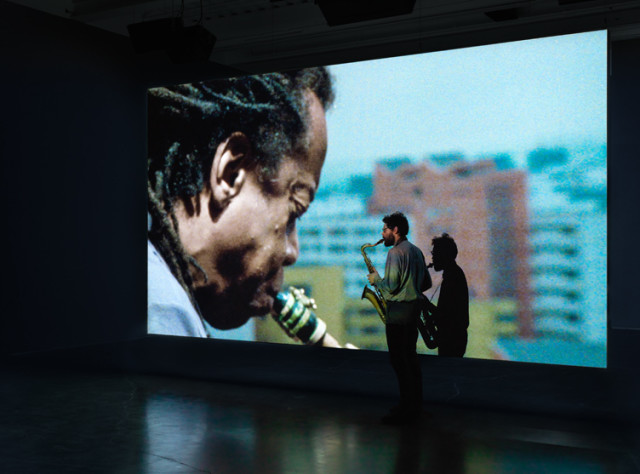Art & Exhibitions
Anri Sala Speaks on Improv, and Race
THE DAILY PIC: Sala shares some thoughts on his stunning New Museum work.

THE DAILY PIC: Sala shares some thoughts on his stunning New Museum work.

Blake Gopnik


THE DAILY PIC (#1519): The New Museum show called “Answer Me,” of major video installations by the Albanian-born Berliner Anri Sala, has got to be the most rewarding exhibition in New York right now, and probably the most demanding and complex. In today’s New York Times I published a Q&A with Sala, but as always lots had to be left out for space.
Here are a few Sala thoughts that didn’t make it onto the page, about his piece called Long Sorrow, seen in today’s Pic. For the video, Sala suspended the American saxophonist Jemeel Moondoc 25 stories up on the façade of a building in Berlin, and asked him to play his heart out.
–Sala on his choice of a musician who plays Free Jazz:
Psychologically it was very difficult for the musician to be suspended in that void. The only way for someone to forget that situation was to be in a state of improvisation – in Free Jazz, you are constantly inventing, you are looking for the next moment. I wanted to produce an alertness, an awareness of something that is at stake right here and right now – and this has to do with the musician improvising, trying to forget that he is suspended in the void, trying to find the moment after.
–On his decision to use an African American musician, in particular:
I chose Jemeel for his quality as a musician, not for his appearance. I was also interested in him because I did not want a musician whose appearance would welcome the existing projections of viewers – for example, if he’d been somebody who looked like he could be an immigrant from Poland or from Russia. I did not want the film to become a projection of local politics, and in Berlin, you don’t see many people of color, so they do not immediately express something beyond themselves.
It’s impossible to completely escape the projections [of your audience]: My film was shot in Berlin, so of course it also carries the history of a place where a political will existed at some point that was anti-semitic, racist. But at least in terms of the immediate social readings people give, the film is completely open to interpretation. (Photo by Maris Hutchinson/EPW Studio, courtesy the New Museum)
For a full survey of past Daily Pics visit blakegopnik.com/archive.